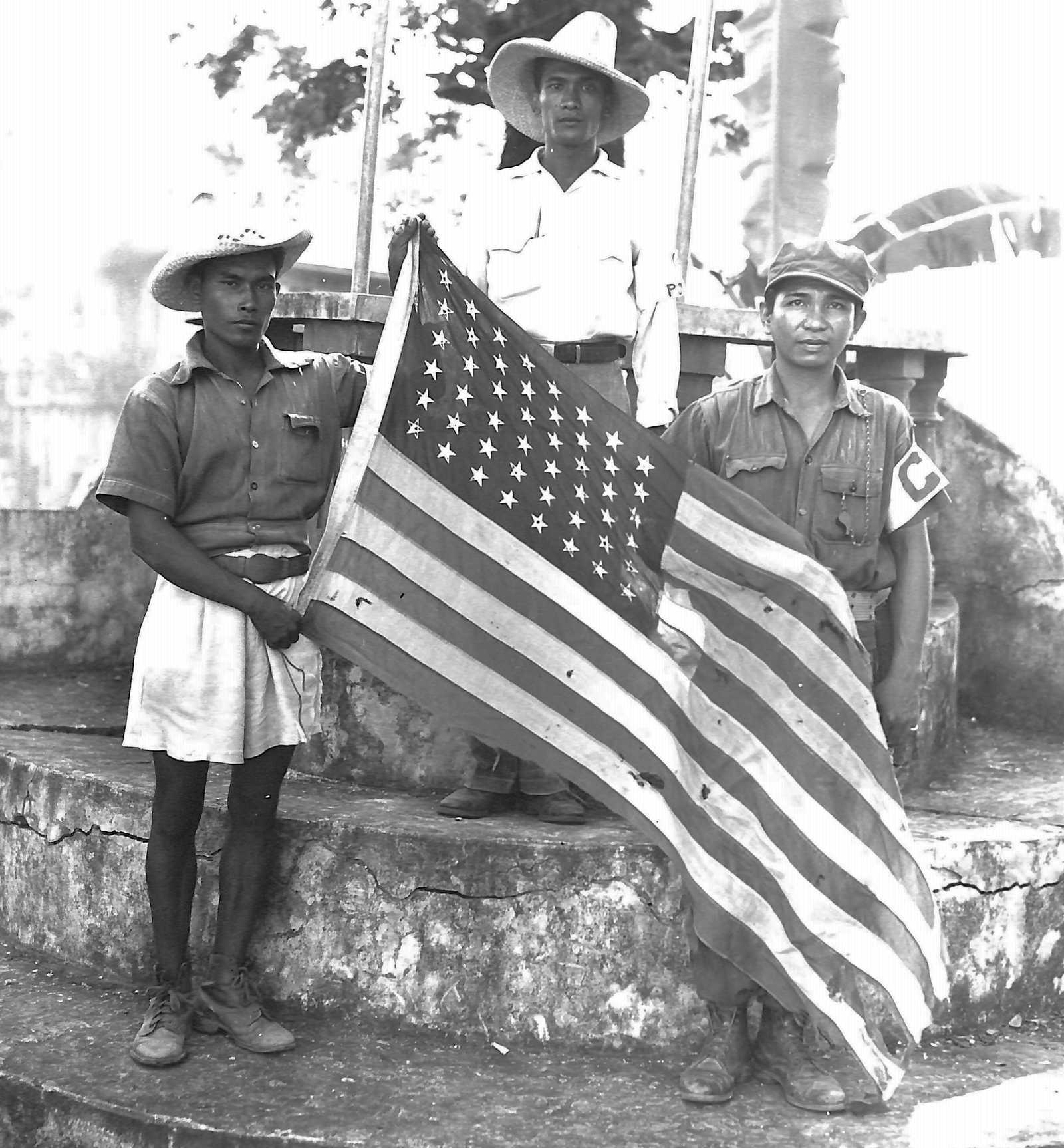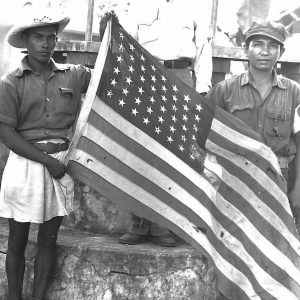Lesson Plan 9:

Who Were the Guerrillas?
In this lesson, designed for middle schoolers, students define guerrilla and identify types of guerrilla service, as well as challenges and successes of World War II guerrilla fighters in the Philippines.
Summary
In this lesson, students will examine a primary source and explore an online exhibit in order to define guerrilla fighters and find examples of the kinds of service they performed in the Philippines during World War II. Students will complete a content map about guerrillas, gathering and then synthesizing information about who they were, why they fought, the challenges they faced, and their accomplishments.
Information about the guerrillas can be found in the online exhibit Under One Flag, spread across several sections. Most important are sections 4-7 in Chapter 2: The Crucible of War (Occupation, Guerrillas, Liberation, Devastation and Victory). Instructions include suggestions for breaking this material down based on student ability and time, including alternative strategies that rely on animations and illustrations rather than exhibit text.
Key Ideas
1. Guerrillas fought at great personal risk and with incredible bravery against long odds, with few resources.
2. Guerrillas supported the fight against the Japanese in a variety of ways.
Time:
45 minutes
Materials
- “Filipino Guerrillas with American Flag” handout
- Guerrillas content mapping worksheet
- Laptops or tablets to access online exhibit “Under One Flag”
Grade Level/Subject
Middle School Social Studies
Common Core: Middle School
- CCSS.ELA-LITERACY.RH.6-8.2: Determine the central ideas or information of a primary or secondary source; provide an accurate summary of the source distinct from prior knowledge or opinions.
- CCSS.ELA-LITERACY.RH.6-8.4: Determine the meaning of words and phrases as they are used in a text, including vocabulary specific to domains related to history/social studies.
- CCSS.ELA-LITERACY.RH.6-8.7: Integrate visual information (e.g., in charts, graphs, photographs, videos, or maps) with other information in print and digital texts.
UCLA Public History Initiative | US History Content Standards
- Era 8, Standard 3: The causes and course of World War II, the character of the war at home and abroad, and its reshaping of the U.S. role in world affairs.
UCLA Public History Initiative | World History Content Standards
- Era 8, Standard 4B: The student understands the global scope, outcome, and human costs of World War II.
Instructions
1. Introduction: Who Were the guerrillas? (10 minutes)
Show photo of Filipino guerrillas with the American flag, taken shortly after the liberation of the Philippines in 1945. Lead students through guided looking to surface prior knowledge about guerrillas and World War II in the Philippines. Students can make inferences about the challenges guerrillas faced and their motivations from the photograph and caption. (Guided looking instructions and more background information is included in the Guerrillas with Flag Explainer: https://dutytocountry.org/project/explainer-12/).
Tell students that during today’s lesson, they’ll be learning about guerrilla fighters in the Philippines during World War II, learning about who they were, what kinds of actions they took during the war, the challenges they faced, and what they accomplished. They will do so by visiting an online exhibit with text, photographs, short videos, and interviews.
2. Content Mapping (30 minutes)
Pass out the content mapping worksheet for guerrillas. Lead students in writing a definition of guerrillas in the center circle (see below). Spend time breaking down new or unfamiliar terms (grassroots, irregular).
- Guerrilla: A member of a small independent, grassroots group who takes part in irregular fighting against larger, official military or police forces.
Once students have the basic definition of guerrillas in mind, walk them through the four sections of the worksheet so they know what information they will be gathering from the exhibit. They will be looking for basic facts about who the guerrillas were, examples of the types of military service they provided, the challenges and hardships they faced, and what they accomplished.
Information about Filipino guerrillas is sprinkled throughout the Under One Flag exhibit, especially in sections 4-7 of Chapter 2: The Crucible of War (Occupation, Guerrillas, Liberation, Devastation and Victory). There are a number of ways to differentiate this section depending on the level of students and time available. Various suggestions are provided below:
- Have students work in small groups, with each member of the group assigned a different section of the exhibit to review to complete the worksheet. Alternatively, assign each student in a four-member group a different section of the worksheet. In either case, leave time for students to share what they learned with each other.
- Select one (“guerrillas”) or only a couple of exhibit sections depending on time, or so that information is not so overwhelming for lower level students.
- In a mixed-ability classroom or groups, assign students different kinds of media to review in the exhibit. More advanced students can be responsible for reviewing the text, lower-level readers can review photographs and captions, more auditory processors can watch the animations and videos, etc.
- You can also have students focus simply on the Profile Cards (https://exhibition.dutytocountry.org/profile-cards/) and Animations (https://exhibition.dutytocountry.org/animation-gallery/) of guerrilla fighters, gathering information from the texts and making additional inferences from the illustrations. This strategy may work best for kinesthetic, visual and auditory learners as it involves manipulatives and/or videos.
- Key profiles: Celestino Almeda, Edwin Ramsey, Jesse Baltazar, Yay Panillo, Magdalena Leones, Wendell Fertig, Remedios Gomez-Paraiso
- Key animations: Under the Hood, The Liberator, Women of the Resistance, Messenger for the Guerrillas, Forged Under Fire
- As part of synthesis, have students compare and contrast guerrillas (independent, little/no training, few weapons, sabotage, sharing information, quick strikes, men and women fighters) with typical military forces (official part of government, well-trained, ample access to weapons and supplies, open combat, only male fighters, etc.).
3. Synthesize Guerrilla Service (5 minutes)
Return to the photo of guerrillas that started the lesson. Knowing what they know now, what other details from the photos jump out? What signs of hardship and bravery do they see in the photo? Why would guerrillas have hidden the flag? Conclude with a discussion of what kinds of expectations Filipino guerrillas would have had of the U.S. based on their service during the war. Ask students to name ways that their service could have been fairly recognized and rewarded.
Related Explainers
Filipino Guerrillas with American Flag, circa 1945
This photo was taken shortly after the liberation of the Philippines. The original caption reads “US. Flag was hidden for three years in Malsiqui Luzon, Capt. of Pinlae unit with two other Guerrillas.”

Source: U.S. Army Signal Corps, January 1945.
Content Map: Filipino guerrillas



